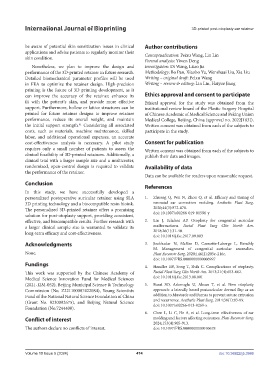Page 482 - IJB-10-5
P. 482
International Journal of Bioprinting 3D-printed post-otoplasty ear retainer
be aware of potential skin sensitization issues in clinical Author contributions
applications and advise patients to regularly monitor their Conceptualization: Peixu Wang, Lin Lin
skin condition.
Formal analysis: Yiwen Deng
Nonetheless, we plan to improve the design and Investigation: Di Wang, Litao Jia
performance of the 3D-printed retainer in future research. Methodology: Bo Pan, Xiaobo Yu, Wenshuai Liu, Xia Liu
Detailed biomechanical parameter profiles will be used Writing – original draft: Peixu Wang
in FEA to optimize the retainer design. High-precision Writing – review & editing: Lin Lin, Haiyue Jiang
printing is the future of 3D printing development, as it
can improve the accuracy of the retainer, enhance its Ethics approval and consent to participate
fit with the patient’s skin, and provide more effective Ethical approval for the study was obtained from the
support. Furthermore, hollow or lattice structures can be institutional review board of the Plastic Surgery Hospital
printed for future retainer designs to improve retainer of Chinese Academic of Medical Science and Peking Union
performance, reduce its overall weight, and maintain Medical College, Beijing, China (approval no. 2022[183]).
the initial support strength. Considering all associated Written consent was obtained from each of the subjects to
41
costs, such as materials, machine maintenance, skilled participate in the study.
labor, and additional operational expenses, an accurate
cost-effectiveness analysis is necessary. A pilot study Consent for publication
requires only a small number of patients to assess the Written consent was obtained from each of the subjects to
clinical feasibility of 3D-printed retainers. Additionally, a publish their data and images.
clinical trial with a larger sample size and a multicenter,
randomized, open-control design is required to validate Availability of data
the performance of the retainer.
Data can be available for readers upon reasonable request.
Conclusion
References
In this study, we have successfully developed a
personalized postoperative auricular retainer using SLA 1. Zhuang Q, Wei N, Zhou Q, et al. Efficacy and timing of
3D printing technology and a biocompatible resin bioink. neonatal ear correction molding. Aesthetic Plast Surg.
The personalized 3D-printed retainer offers a promising 2020;44(3):872-878.
doi: 10.1007/s00266-019-01596-y
solution for post-otoplasty support, providing consistent,
effective, and biocompatible results. Further research with 2. Lin J, Sclafani AP. Otoplasty for congenital auricular
a larger clinical sample size is warranted to validate its malformations. Facial Plast Surg Clin North Am.
long-term efficacy and cost-effectiveness. 2018;26(1):31-40.
doi: 10.1016/j.fsc.2017.09.003
Acknowledgments 3. Joukhadar N, McKee D, Caouette-Laberge L, Bezuhly
M. Management of congenital auricular anomalies.
None. Plast Reconstr Surg. 2020;146(2):205e-216e.
doi: 10.1097/PRS.0000000000006997
Fundings 4. Handler EB, Song T, Shih C. Complications of otoplasty.
This work was supported by the Chinese Academy of Facial Plast Surg Clin North Am. 2013;21(4):653-662.
Medical Science Innovation Fund for Medical Sciences doi: 10.1016/j.fsc.2013.08.001
(2021-I2M-052), Beijing Municipal Science & Technology 5. Basat SO, Askeroglu U, Aksan T, et al. New otoplasty
Commission (No. Z221100007422084), Young Scientists approach: a laterally based postauricular dermal flap as an
Fund of the National Natural Science Foundation of China addition to Mustarde and Furnas to prevent suture extrusion
(Grant No. 8230092675), and Beijing Natural Science and recurrence. Aesthetic Plast Surg. 2014;38(1):83-89.
doi: 10.1007/s00266-013-0269-z
Foundation (No.7244400).
6. Chen L, Li C, He A, et al. Long-term effectiveness of ear
Conflict of interest molding and factors affecting outcomes. Plast Reconstr Surg.
2024;153(4):905-913.
The authors declare no conflicts of interest. doi: 10.1097/PRS.0000000000010678
Volume 10 Issue 5 (2024) 474 doi: 10.36922/ijb.3986

